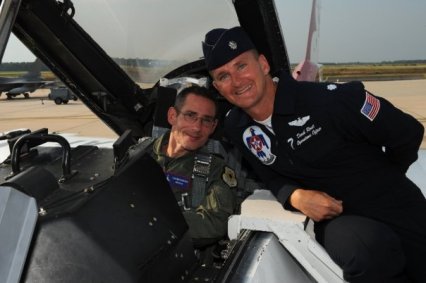
An unnatural gurgling came from my chest as my lungs began to give way under 1,350 pounds of pressure. The sound. That’s what jogged my memory.
Oh yeah, I had to breathe.
I was in the rear seat of an F-16 Fighting Falcon pulling 9Gs — or nine times the force of gravity — on Monday evening for a looping, whirling, hard-banking thrill ride that few civilians ever get the chance to experience.
It was a ride-along with a member of the elite U.S. Air Force Thunderbirds demonstration team, the headline act at today’s Atlantic City Air Show, and it was every bit as exhilarating as I’d imagined. Roller coasters will never be the same.
Over the course of 60 minutes, my pilot, Lt. Col. Derek Routt, took me through many of the aerial gymnastics America’s fighting pilots experience in real-world combat. We dove hard to “kill” cars on a bridge, fired imaginary missiles at clouds, flew sideways and upside down, took head-snapping turns at more than 600 mph and spun until I was silly.
And that was with Routt going easy on me. The F-16/D — in this case Thunderbird 7 — is a 49-foot fire-breather capable of topping 1,500 mph, or twice the speed of sound. Though the F-16 is a venerable platform that first flew in the 1970s, updated versions are still considered among the most reliable and effective jets for tactical bombing and air-to-air combat. Fighter jocks call them Vipers.
Like the Navy’s Blue Angels, the Thunderbirds, based at Nellis Air Force Base in Nevada, are some of the world’s finest pilots, conditioned to withstand brutal forces with a clearheadedness that defies explanation. During today’s air show over the beach and boardwalk, six Thunderbird pilots will perform dozens of maneuvers, none more dicey than the famed “diamond formation,” in which four jets fly as close as 18 inches apart.
It takes nerves, confidence and intense training, all of which Routt has in abundance. A married father of three, the 39-year-old pilot is known as Tazz, for Tasmanian Devil.
“I’m a bit spun up,” he says by way of explanation.
That was clear the second I walked onto the tarmac at Atlantic City International Airport, home of the New Jersey Air National Guard’s 177th Fighter Wing, which is running logistics for the show.
Routt whooped and hollered at the sight of his air crew, responsible for ensuring the red, white and blue jet is at peak performance. Routt might be the star, but he doesn’t get in the air without these men and women, who won’t get a chance to ride until the end of their three- to four-year hitches.
Routt, 39, is also the first Thunderbird pilot to come from the Air National Guard, in his case the Nevada Guard. That’s no small source of pride for people like Col. Bob Bolton, commander of the 177th, whose New Jersey fliers and support personnel rotate in and out of Iraq.
“It symbolizes how the Guard supports the Air Force in everything they do,” Bolton says. “We’re an integral part of the Air Force.”
Before we took to the air, I was given a crash course in equipment, bailout procedures and breathing techniques.
G forces swiftly draw blood away from the head and toward the ankles, leading to G-LOC, or G-induced loss of consciousness. That would be the black cloud. To counter the beast, Maj. Charla Quayle, the team’s flight surgeon, demonstrated how to clench the leg and butt muscles, taking in short, sharp breaths every three seconds with a pronounced “k” sound.
Holding your breath through a G run is a bad idea. It allows the pressure to build in the chest, squeezing the lungs and heart. Hence the awful gurgling sound.
“As long as I’ve been flight surgeon, no one has G-LOC’d on me, ” Quayle says, offering comfort, not cockiness. I didn’t want to be the first schlub to black out on her.
Once strapped in to the jet, we taxied for our 6 p.m. flight.
“Here we go, man,” Routt says, his voice all childlike excitement.
The engines kicked in, and Routt called it out.
“100 knots, 200 knots, there’s 300, 350. All set?”
“All set.”
Somewhere between 350 and 400 knots, or 402 mph to 460 mph, we were wheels up, and the world fell away as Routt blasted arrow-straight into the sky.
In little more than 10 seconds, we’d reached 7,000 feet, the jet’s canopy providing a panoramic view of earth and sky. Soon we were flying upside down, and I was offering up “wows” and “holy cows” like some awestruck kid, which is exactly how I felt.
Within minutes, we reached restricted airspace over Maryland, where Routt was free to do maneuvers without fear of air traffic. We performed corkscrew-like barrel rolls, loops that left circles of smoke in the sky and one nausea-inducing aileron roll, in which the plane spun in a tight circle. Routt wasn’t the least bit dizzy.
After sucking up some pure oxygen and a few sips of water, I settled down, and we made our 9G run, a hard bank called a high-performance turn. Routt whooped again. In the back, I was pinned to the seat, the blackness closing in, when I remembered to breathe in “k” sounds. The flight surgeon’s string remains unbroken.
We headed home — sideways — up the coast at 2,500 feet, low enough to spot sunbathers on the beach in Ocean City, Md., Wildwood and every other Shore town. In Atlantic City, we cruised in low over the casinos and hotels, landing soft on the runway.
Despite the incredible one-hour ride, I was happy to be back on terra firma. Not Routt.
“Nothing like it in the world,” he said. “If I could, I’d fly every day.”